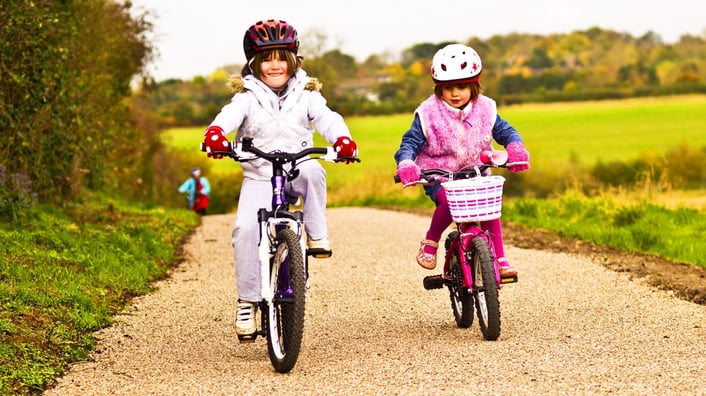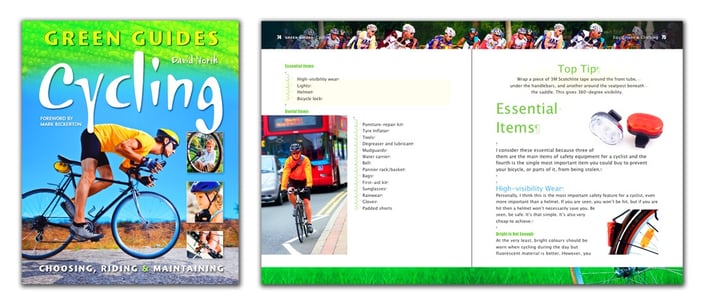
Cycling is great for children in all sorts of ways, whether as passengers on your bicycle going to school or the shops, travelling independently on their own bicycles, or simply enjoying cycling for sport and recreation. It’s all good, wholesome fun. Today's blog looks at the basics of getting children involved in cycling and cover the key safety issues.
Early Start
You can involve children in cycling from the very beginning of their lives. A newborn baby can be transported in a bicycle trailer and an older baby can be carried in a child seat attached to your bicycle. There are also tandem bikes, trailer bikes and tow bars that offer a range of other ways to involve smaller children.
Child Trailers
Trailers for children are becoming more popular and, should you wish to try before you buy, they are often available at bicycle hire centres. They will have a safety harness, at least one seat, possibly two, a rain cover, windows and other features depending on the make. Most can fold easily, helping with storage and transportation. They are attached to your bicycle with a bar. Carrying capacity is around 45 kg (100 lbs). If you want to carry a newborn baby, make sure that the trailer you buy has the necessary fittings.
Child Seats
For a baby that is able to support its own head you can mount a child seat in front of you, between the saddle and handlebars, or behind you:
- Front seats: Front-fitting seats are less common than rear-fitting ones. You might feel happier having your baby in front, though not many offer support for the shoulders and head, which are useful to have if your baby falls asleep. Some riders manage this by supporting their baby’s head with a hand, but that means less control of the bicycle so isn’t recommended. The weight limit of these seats is around 15 kg (34 lbs).
- Rear seats: These are much more common than front seats, offering a wider variety of features, such as adjustable headrests, reclining backs, rain covers and storage compart-ments. The weight capacity ranges from around 18 kg (40 lbs) for basic seats, to 22 kg (48 lbs) for better-quality ones. Seats that attach to a rear pannier rack will generally be sturdier.
Trailer Bikes
Also known as a ‘tag-a-long’, this is effectively the back half of a child’s bicycle, the front section being a frame that attaches to the rear of your bicycle, so there is no front wheel or steering. They are for children aged between four and nine. The child can pedal or just freewheel. There are also tandem versions so two children can be towed, although you might want to encourage them to help with the pedalling!
Tow Bars
Similar to a trailer bike is a tow bar, although you will need to check the fittings, weight and suitability for your child’s bicycle. The tow bar attaches to the child’s bicycle, converting it into a trailer bike. When attached, the bar lifts the front wheel of the child’s bicycle off the ground so they cannot steer, but they can pedal if they wish. The weight limit of these bars is around 30kg (65 lbs) including the child and the bicycle.
Learning to Ride
In terms of the very basic skills of being able to balance and pedal without crashing into something, the vast majority of children learn to do this in their own good time. However, here's you can help to make it a quicker and easier process for them:
- No pedals: Start training without pedals, and remove any stabilizers. You can buy trainer bicycles without pedals in the smallest wheel size for children, or remove the pedals from a standard bicycle. Make sure that the seat is low enough so your child can sit with his or her feet flat on the ground. It will only take a handful of practice sessions, on a gentle slope, for your child to develop good balance.
- With pedals: Once your child has learnt to balance well, he or she can then start to learn with pedals. As starting is the difficult part of maintaining balance, give your child a gentle push so that he or she achieves the momentum necessary for maintaining balance without having to pedal. Once moving and balanced, they can try the pedals. They will only manage a few revolutions before having to put a foot down but, with a few practice sessions, they will soon get the hang of it.
Equipment
A prime reason for accidents involving child cyclists is that motorists don’t see the child. Once an accident occurs, the main cause of fatality and serious injury is trauma to the head. For your child’s safety make sure he or she uses the following:
- Clothing: Bright clothing should always be worn and preferably with reflective material like 3M Scotchlite. This can be integrated into cycle clothing and bags, or you can buy it as a self-adhesive roll and attach it to items the child will wear when cycling.
- Flag: You can buy safety flags, usually sold for recumbent cyclists, that easily attach to the back of the child’s bicycle. These are important as a child on a bicycle can be low to the ground and missed by motorists.
- Reflectors: Fit four reflectors, front and rear and both sides. The side reflectors attach to the spokes of the wheels.
- Lights: There should be two, one at the front and one at the rear, and they should be available to the child at any time, including during the day, if he or she is cycling anywhere near a road. Ideally, fit dynamo lights. The child can simply ride with them on all the time.
- Helmet: There are many but they are not all of equal quality. The best have Snell certification. To find out more visit the website www.smf.org.
Here are a couple of things to stay aware of regarding children's cycling safety that we haven't adressed:
- Driveway: A very high proportion of accidents involving children occur when they ride out of their driveway onto the road. Don’t let them do it. Walk the bicycle out and onto the pavement or road and then mount the bicycle when the road is clear.
- Pavement: Let children, up to teenage, cycle on the pavement where roads are busy. Police officers will make an exception for them. It is best for the child to ride on the outer edge of the pavement as cars may pull out of driveways. Make sure your child is aware of this possibility and is on the alert.
- Junctions: Rather than attempt to negotiate these, including roundabouts, it will be safer for the child to use a pedestrian crossing.
This is just a snippet of the expert advice that can be found in our book Cycling: Green Guides. Take a closer look at the title here, or click here for Amazon.
- Looking to purchase a new bike? Click here for some expert advice
- To learn how to replace a worn chain, click here
- Or for tips on brake maintenance, click here




